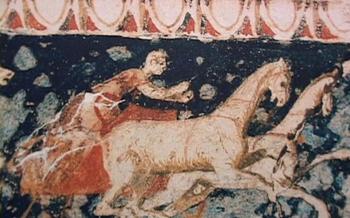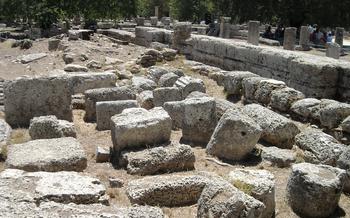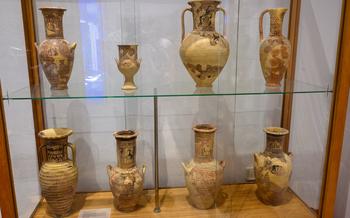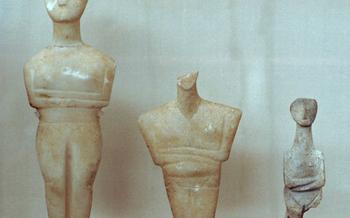
The Lion of Amphipolis
- The Lion Monument in Amphipolis:
- Excavations and Findings
- Hellenistic Influence:
- Historical Background
- Natural Surroundings:
- Local Cuisine:
- Festivals and Events
- Accommodation Options
- Transportation
- Day Trips and Excursions
- Local Culture and Traditions
- Shopping
- Nightlife
- Insider Tip: Unveiling Amphipolis' Hidden Treasures
The Lion Monument in Amphipolis:
The Lion of Amphipolis, a colossal marble sculpture dating back to the 4th century BC, stands as an iconic symbol of ancient Greek culture and history. This majestic monument, carved from a single block of white marble, depicts a majestic lion, embodying strength, power, and pride. Its placement atop a large mound overlooking the ancient city of Amphipolis further adds to its imposing presence.
Legends and myths surround this remarkable monument. One legend attributes its creation to Alexander the Great, who is said to have commissioned it to honor his loyal companion, Bucephalus, the horse that carried him to victory in countless battles. Another legend suggests that the lion was erected to guard the tomb of a Thracian king or a prominent military leader.
The architectural features of the Lion of Amphipolis showcase the exceptional craftsmanship of ancient Greek sculptors. The lion's muscular body, intricate mane, and expressive features are meticulously rendered, capturing the essence of the animal's nobility and strength. The monument's construction involved advanced techniques, including precision carving, polishing, and transportation of the massive marble block from a distant quarry.
In ancient Greece, the lion held significant symbolic meaning. Often associated with the gods, particularly Zeus, the king of the gods, the lion represented power, authority, and protection. Its placement at the entrance of Amphipolis, a strategically important city, reflects the city's strength and its role as a guardian of the region.
Excavations and Findings
Amphipolis has been a site of extensive archaeological excavations since the 19th century, revealing a wealth of significant artifacts and structures that shed light on the city's rich history. One of the most notable discoveries was the tomb of Kasta, dating back to the 4th century BC, which contained exquisite gold jewelry and other valuable objects. The excavations also uncovered the remains of a large theater, a gymnasium, and a public bath complex, providing further evidence of the city's cultural and civic importance. These findings have played a crucial role in understanding the daily lives and customs of the ancient Greeks, as well as the architectural and artistic achievements of the Hellenistic period.
Ongoing research at Amphipolis continues to uncover new insights into the city's past. Recent excavations have focused on the area around the lion monument, revealing additional structures and artifacts that provide clues to the monument's original purpose and significance. The ongoing exploration of Amphipolis holds the potential for even more exciting discoveries, offering a glimpse into the vibrant and multifaceted world of ancient Greece.
Hellenistic Influence:
During the Hellenistic period, Amphipolis flourished as a significant city, showcasing the profound influence of Greek culture and civilization. The Lion Monument itself exemplifies this influence, embodying the artistic and architectural styles prevalent in the Hellenistic era. Its construction and design reflect the grandeur and opulence characteristic of Hellenistic art, emphasizing intricate details, realism, and a harmonious blend of Greek and Oriental elements. The monument stands as a testament to the cultural exchange and synthesis that occurred during this period, leaving an indelible mark on the region's identity.
The Hellenistic period was a time of significant cultural and intellectual development in Greece. It was during this time that the Greek language and culture spread throughout the Mediterranean and beyond. This period also saw the rise of new philosophical and scientific schools, such as the Stoics and the Epicureans.
The Hellenistic influence in Amphipolis can be seen in the city's architecture, art, and religion. The city was laid out on a grid plan, with wide streets and public squares. The buildings were typically made of stone and featured columns, pediments, and other classical architectural elements. The city was also home to a number of temples, theaters, and other public buildings.
The Hellenistic influence in Amphipolis is a reminder of the city's rich history and its importance as a center of culture and learning in the ancient world.
Historical Background
Amphipolis, a city of strategic significance in ancient Greece, was founded in 437 BC by the Athenians, led by the famed general Agnon. Situated at the crossroads of important trade routes and commanding the Strymon River, Amphipolis quickly rose to prominence. Its location allowed for control over the region's mineral resources, including gold and silver mines, and facilitated trade between the Aegean Sea and the hinterland.
During the Peloponnesian War (431-404 BC), Amphipolis became a focal point of conflict between Athens and Sparta. The city's strategic position made it a prized possession, and both sides fought fiercely to gain control. In 424 BC, the Spartans, led by Brasidas, captured Amphipolis, dealing a significant blow to Athenian power in the region.
Amphipolis remained under Spartan control until 357 BC when it was liberated by Philip II of Macedon, father of Alexander the Great. Philip recognized the city's importance and made it the capital of his newly conquered territory in Thrace. Under Macedonian rule, Amphipolis flourished and became a center of Hellenistic culture and learning.
Throughout its history, Amphipolis served as a vital military outpost, guarding the Macedonian kingdom from invasions from the north. Its strategic location and strong fortifications made it a formidable defensive position, contributing to the stability and security of the region.
Natural Surroundings:
Amphipolis is nestled amidst a breathtaking natural landscape that offers a perfect blend of scenic beauty and outdoor adventure. The region is a haven for nature enthusiasts, with its rolling hills, lush forests, and sparkling rivers providing ample opportunities for exploration and recreation.
Hiking trails wind through the picturesque countryside, inviting visitors to immerse themselves in the tranquility of nature. Admire the stunning vistas from atop Mount Pangaeus, the highest peak in the region, or explore the verdant forests that carpet the surrounding hills.
For those seeking a more adrenaline-pumping experience, mountain biking trails offer a challenging and exhilarating ride through the rugged terrain. Observe the rich diversity of flora and fauna, including rare and endangered species that call this region home.
Birdwatching enthusiasts will delight in the variety of avian species that grace the skies above Amphipolis. From majestic eagles soaring overhead to colorful songbirds flitting among the trees, the region is a haven for bird lovers.
The pristine waters of the Strymon River offer a refreshing respite from the summer heat. Take a dip in the cool, clear waters, or embark on a leisurely kayaking or canoeing excursion to explore the river's tranquil beauty.
Amphipolis is a place where nature and history intersect, creating a harmonious blend of cultural heritage and natural wonders. Whether you're seeking adventure, relaxation, or a chance to connect with the natural world, this region offers an unforgettable experience.
Local Cuisine:
The culinary delights of Amphipolis showcase the region's rich cultural heritage and the influence of Greek and Mediterranean cuisine. Traditional dishes are prepared using fresh, locally sourced ingredients, reflecting the bounty of the land and sea.
Savory dishes like pastitsio, a baked pasta dish with minced meat and béchamel sauce, and moussaka, a layered casserole of eggplant, potatoes, and ground meat, are must-try delicacies. Freshly caught seafood is a highlight, with grilled octopus, fried calamari, and succulent shrimp being popular choices.
For a taste of local flavors, indulge in traditional meze platters, a selection of small dishes served with ouzo or tsipouro, the local anise-flavored spirit. These platters often include grilled meats, fried cheese, dolmades (stuffed grape leaves), and tzatziki, a refreshing yogurt-based sauce.
Don't miss out on the region's delectable sweets, such as baklava, a filo pastry filled with chopped nuts and honey syrup, and loukoumades, fried dough balls drizzled with honey and cinnamon. For a unique culinary experience, visit the local markets to sample fresh produce, handmade cheeses, and traditional pastries.
When it comes to dining, Amphipolis offers a range of options, from traditional tavernas to modern restaurants. For an authentic experience, head to the family-run tavernas in the old town, where you can savor homemade dishes and soak up the local atmosphere. If you prefer a more upscale dining experience, there are several restaurants offering innovative takes on traditional Greek cuisine.
Festivals and Events
Amphipolis comes alive during its annual cultural events and festivals, showcasing the rich traditions, music, and dance of the region. These celebrations provide an immersive experience, allowing visitors to interact with locals and learn about their customs firsthand.
One of the most popular events is the Amphipolis Festival, held every summer in the ancient theater. This festival features performances by renowned Greek and international artists, as well as traditional dance troupes and musicians. Visitors can enjoy live music concerts, theatrical productions, and dance performances against the backdrop of the ancient ruins, creating a magical atmosphere.
Another highlight is the Feast of Agios Panteleimon, celebrated on July 27th. This religious festival honors the patron saint of Amphipolis and attracts thousands of pilgrims and visitors. The city transforms into a vibrant hub of activity, with processions, traditional music, and dancing filling the streets.
For those interested in history and archaeology, the Amphipolis Archaeological Museum hosts regular events and workshops related to the ancient city and its excavations. These events provide an opportunity to learn more about the fascinating discoveries made at the site and their significance in understanding ancient Greek history.
Practical information on festival dates, ticket prices, and event schedules can be found on the official website of Amphipolis or through local tourism offices. Whether you're a history buff, music lover, or simply looking for a unique cultural experience, Amphipolis' festivals and events offer something for everyone.
Accommodation Options
Amphipolis offers a variety of accommodation options to suit different budgets and preferences. Budget travelers can choose from hostels and guesthouses that provide basic amenities at an affordable price. For a more comfortable stay, there are mid-range hotels that offer a range of services and amenities. Luxury travelers can opt for high-end hotels that provide a truly indulgent experience.
When choosing accommodation, consider your location and budget. If you're on a tight budget, hostels and guesthouses are a great option. They're often located in the city center, close to restaurants, shops, and attractions. Mid-range hotels offer a good balance of price and comfort, and they're usually located within walking distance of the main attractions. Luxury hotels are typically located in more upscale areas and offer a range of amenities, such as spas, pools, and fitness centers.
To find the best deals on accommodation, it's a good idea to book in advance, especially during peak season. You can use online booking platforms to compare prices and read reviews from other travelers. It's also worth checking with local tourist information centers for recommendations and discounts.
Transportation
Amphipolis is conveniently accessible by road, rail, and air. The city is well-connected to major cities in Greece and beyond, making it an easy destination to reach.
By Road: Amphipolis is accessible by road through the Egnatia Odos Motorway (A2), which connects the city to Thessaloniki and other major cities in Greece. The journey from Thessaloniki takes approximately 1 hour and 30 minutes by car.
By Rail: Amphipolis has a train station that offers regular services to Thessaloniki and other destinations in Greece. The journey from Thessaloniki by train takes about 2 hours and 30 minutes.
By Air: The nearest airport to Amphipolis is Thessaloniki International Airport (SKG), which is located about 100 kilometers from the city. From the airport, you can take a bus or taxi to reach Amphipolis. The journey by bus takes approximately 2 hours, while a taxi ride takes around 1 hour and 30 minutes.
Public Transportation: Once in Amphipolis, you can get around the city using public transportation. The city has a local bus network that connects different parts of the city. You can also rent a bicycle or a car to explore the city and its surroundings at your own pace.
Renting a Car or Hiring a Taxi: If you prefer to have more flexibility and explore the region at your own pace, you can rent a car or hire a taxi. There are several car rental agencies in Amphipolis where you can rent a vehicle. Taxis are also readily available and can be hailed on the street or booked in advance.
Tips for Navigating the Local Transportation System: - When using public transportation, make sure to check the schedules and routes in advance to avoid any inconvenience. - If you are renting a car, be aware of the local driving regulations and customs. - Taxis are generally reliable and safe in Amphipolis, but it's always a good idea to agree on the fare before getting in the taxi.
Day Trips and Excursions
Amphipolis serves as an excellent base for exploring the rich history and culture of the surrounding region. A short drive away, visitors can discover a wealth of captivating destinations that offer unique insights into ancient civilizations and natural wonders.
Nearby Attractions:
-
Philippi: Delve into the ruins of this ancient city, once a prominent site during the Roman and Byzantine periods. Explore its well-preserved amphitheater, agora, and other significant landmarks, including the ruins of Saint Paul's Basilica.
-
Drama: Known for its stunning natural beauty, Drama is surrounded by picturesque mountains, lush forests, and pristine lakes. Visit the city's archaeological museum to learn about the region's ancient past and admire its collection of artifacts.
-
Kavala: Discover the charm of this coastal city, nestled along the Aegean Sea. Wander through its narrow cobblestone streets, admire the remnants of its Byzantine fortress, and relax on its beautiful beaches.
Historical Sites:
-
Amphipolis Archaeological Site: Just outside the city, explore the remains of the ancient city of Amphipolis, including the impressive city walls, public buildings, and the famous Lion of Amphipolis monument.
-
Vergina: Journey to the ancient city of Aegae, the first capital of the Kingdom of Macedonia. Visit the Royal Tombs of Vergina, a UNESCO World Heritage site, and marvel at the exquisite golden artifacts discovered within.
-
Dion: Explore the ruins of this ancient city, located at the foot of Mount Olympus. Discover the well-preserved theater, temples, and other structures that offer a glimpse into the grandeur of ancient Greek civilization.
Organized Tours:
For those who prefer a hassle-free experience, organized tours are available from Amphipolis, offering guided visits to nearby attractions. These tours provide transportation, expert commentary, and convenient itineraries, allowing visitors to make the most of their time in the region.
Planning Your Excursion:
-
Research: Before embarking on a day trip, research the destinations you plan to visit, including their historical significance, opening hours, and admission fees.
-
Plan Your Route: Create an itinerary that allows sufficient time to explore each destination without feeling rushed. Consider the distances between sites and plan your route accordingly.
-
Pack Essentials: Bring comfortable walking shoes, sunscreen, a hat, and plenty of water, especially if visiting during the summer months.
-
Explore Like a Local: Engage with the locals, ask for recommendations, and immerse yourself in the local culture to enhance your travel experience.
Local Culture and Traditions
Amphipolis is a treasure trove of unique customs, beliefs, and traditions that reflect the rich cultural heritage of the region. As a visitor, it is essential to respect local customs and embrace the opportunity to learn about and experience traditional Greek hospitality.
One of the most notable traditions in Amphipolis is the celebration of religious holidays. The city comes alive during festivals such as Easter and Christmas, with colorful processions, traditional music, and dancing filling the streets. These celebrations are a testament to the deep religious faith and devotion of the local community.
Another important aspect of local culture is the emphasis on family and community values. The people of Amphipolis are known for their warm and welcoming nature, and they take pride in their strong sense of community spirit. Visitors can witness this firsthand by interacting with locals at traditional gatherings, such as village feasts or coffee shops.
Respecting local customs and showing appreciation for the unique traditions of Amphipolis is essential for a fulfilling and enriching travel experience. By embracing the local culture, visitors can gain a deeper understanding of the region's rich history and heritage.
Shopping
Amphipolis offers a variety of shopping opportunities for visitors to find unique souvenirs and traditional products. The local markets are a great place to experience the vibrant atmosphere and find a variety of items, from fresh produce to handmade crafts. Be sure to visit the Agora (marketplace), where you can find everything from spices and herbs to clothing and jewelry.
For those looking for more specialized items, there are several shops in Amphipolis that sell traditional Greek products, such as hand-woven textiles, pottery, and olive oil. These shops are a great place to find unique gifts or keepsakes to remember your trip.
When shopping in Amphipolis, it's important to respect local customs and be prepared to bargain. Bargaining is a common practice in Greece, and it's a great way to get a good deal on your purchases. However, be sure to be respectful and don't be afraid to walk away if the price is too high.
By supporting local businesses, you'll not only get a unique and authentic experience but also help the local economy. So, take some time to explore the shops and markets of Amphipolis and find some treasures to take home with you.
Nightlife
Amphipolis offers a vibrant nightlife scene that caters to various tastes and preferences. Whether you're looking for a lively bar, a traditional taverna, or a club to dance the night away, you'll find something to your liking in this charming city.
For a truly authentic Greek experience, head to one of the traditional tavernas in the old town. These cozy establishments offer delicious local cuisine, live music, and plenty of opportunities to mingle with the locals. Enjoy a glass of ouzo, sample some meze platters, and let the infectious rhythms of traditional Greek music transport you to another era.
If you prefer a more energetic atmosphere, Amphipolis has several bars and clubs that stay open until the wee hours of the morning. Dance the night away to the latest hits or enjoy a more relaxed evening with friends over cocktails and conversation.
For those seeking a unique experience, consider visiting one of the city's many rooftop bars. These venues offer stunning panoramic views of Amphipolis and its surroundings, creating a magical ambiance for an unforgettable evening. Sip on a refreshing drink, soak in the breathtaking scenery, and let the city's vibrant energy wash over you.
No matter your preference, Amphipolis has something to offer everyone when it comes to nightlife. Whether you're looking for a lively party atmosphere or a more relaxed evening out, you'll find it all in this charming city.
Insider Tip: Unveiling Amphipolis' Hidden Treasures
Beyond the iconic lion monument, Amphipolis holds a treasure trove of hidden gems waiting to be discovered. For those seeking an authentic experience, venture off the beaten path to uncover these lesser-known wonders. Explore the picturesque alleys of the old town, where charming traditional houses line the cobblestone streets. Discover the hidden church of Agios Nikolaos, nestled amidst lush vegetation, offering a serene escape from the city's hustle and bustle. Immerse yourself in the local culture by visiting the weekly farmers' market, where you can mingle with locals and find fresh produce, homemade delicacies, and unique souvenirs. For a unique culinary experience, head to one of the hidden tavernas in the countryside, where you can savor traditional Greek dishes prepared with love and local ingredients. Whether you're an art enthusiast, a history buff, or simply seeking tranquility, Amphipolis has something special to offer every traveler who dares to explore beyond the surface.






